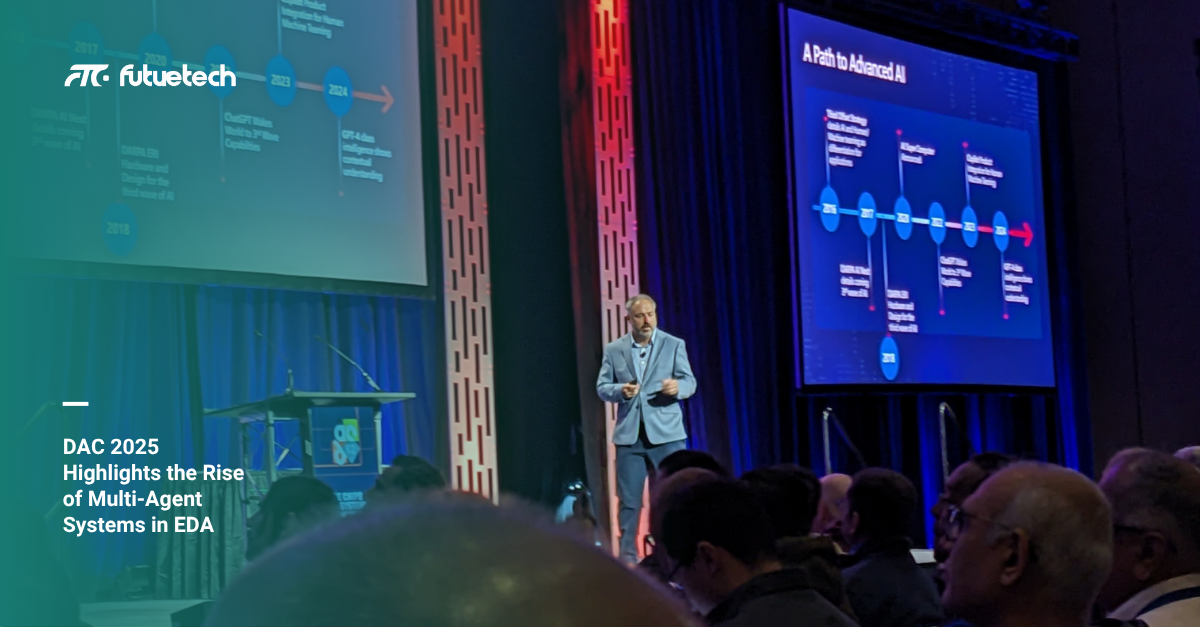Microsoft: Pioneering Multi-Agent Architectures for R&D and Chip Design
In his keynote on Monday, William Chappell, VP and CTO of Strategic Missions and Technologies at Microsoft, presented the company’s advances in agentic workflows using its Discovery R&D platform. He demonstrated a compelling use case in vaccine development, where a task-managing agent coordinated a team of autonomous agents to generate hypotheses, gather data, write code, and evaluate results—delivering eight candidate vaccines within hours.
According to Chappell, these agentic workflows outperform single large language models (LLMs) in tackling complex tasks like scientific research. The same principles are now being applied to chip design through a collaboration between Microsoft and Synopsys, building a multi-agent EDA platform.
A Modular Approach to Intelligent Chip Design
Chappell broke down the chip design process into three stages: Intent to Specification, Specification to RTL, and RTL to Networking. Each stage is supported by a combination of generative and validation agents. For example, agents in the “spec-to-RTL” stage include behavior-to-RTL transformers, test generators, timing analyzers, and verification modules.
“What we’re doing in design mirrors the scientific method,” Chappell noted. “You generate an idea, validate it, simulate outcomes, and refine. The agents keep going as long as there’s evaluation and feedback.”
He emphasized that 2025 will be a pivotal year in integrating these agents with human engineers, enabling a new level of co-design efficiency in silicon development.
Industry Experts Weigh In: Promise and Caution
During a private event hosted by Synopsys and Microsoft, a demo showcased their joint vision for an agent-driven spec-to-RTL system. While optimism was high, a panel of experts outlined challenges that must be addressed before agentic AI can become mainstream in EDA.
● Lack of public datasets: Siddharth Garg, Associate Professor at NYU, highlighted the limited availability of open-source hardware design data, hindering progress compared to software-based generative AI models.
● High risk of design errors: Soumya Banerjee, SVP at Marvell, cautioned against over-reliance on automation. He warned that delegation to agents could reduce engineers’ critical oversight, leading to costly mistakes in chip tape-outs.
● Loss of engineering intuition: Banerjee also noted that automating interpretation of complex reports might erode core engineering skills over time.
● Complementary role of agents: Aman Joshi, VP of Design Enablement at Western Digital, argued that agents will act as “employees of the future,” catching low-level errors and accelerating information retrieval, but should not fully replace human judgment.
Siemens Launches Its EDA AI System
Also at DAC, Siemens EDA introduced its EDA AI System, an AI-powered front-end designed to unify and enhance existing tools with generative and agentic AI capabilities. According to Amit Gupta, VP of Custom IC and AI at Siemens EDA, the platform is architected to integrate with third-party tools and internal AI systems, supporting both standalone applications and end-to-end workflows.
“Our platform is open,” Gupta said. “Customers can bring their own design data and integrate internal or external agents. We’re not replacing their AI investments—we’re amplifying them.”
He added that customers prefer on-premises deployment to maintain data confidentiality and avoid contributing proprietary data to shared training models. The flexibility of Siemens’ system allows organizations to start at the tool level or workflow level depending on their readiness.
The Road Ahead: Toward Collaborative Intelligence in EDA
DAC 2025 made it clear: multi-agent systems are set to redefine the future of chip design. While technical and operational hurdles remain—such as data scarcity, robustness, and human oversight—companies like Microsoft, Synopsys, and Siemens are actively developing the infrastructure to make intelligent, agent-based design workflows a reality.
As a trusted distributor in the electronics supply chain, Futuretech Components stays closely aligned with the cutting edge of semiconductor design and manufacturing innovation. We are committed to delivering high-quality electronic components and responsive service to support design teams navigating this new era of AI-driven EDA. Whether you're working on advanced system-on-chip designs or optimizing your supply strategy, Futuretech is here to help you move forward with confidence.

